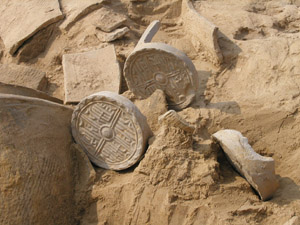An anthropologist at Washington University in St. Louis is helping to reveal for the first time a snapshot of rural life in China during the Han Dynasty.
The rural farming village of Sanyangzhuang was flooded by silt-heavy water from the Yellow River around 2,000 years ago.
Working with Chinese colleagues, T.R. Kidder, PhD, professor and chair of anthropology in Arts & Sciences, is working to excavate the site, which offers a exceptionally well-preserved view of daily life in Western China more than 2,000 years ago.
The research was presented at the Society for American Archeology meeting in St. Louis in April and highlighted this month in Science, the journal of the American Association for the Advancement of Science.
“It’s an amazing find,” Kidder says of the site, which was discovered in 2003. “We are literally sitting on a gold mine of archeology that is untapped.”
What researchers find fascinating and surprising, says Kidder, is that the town, though located in a remote section of the Han Dynasty kingdom, appears quite well off.
Exploration has revealed tiled roofs, compounds with brick foundations, eight-meter deep wells lined with bricks, toilets, cart and human foot tracks, roads and trees.
An abundance of metal tools, including plow shares, have been found, as well as grinding stones and coins. Also found are fossilized impressions of mulberry leaves, which researchers see as a sign of silk cultivation.
“One could make the argument that this is where the Silk Road began,” Kidder says.
Kidder believes the site could be substantially larger than currently is known. The flood of sediment that buried the town also covered an area of more than 1,800 square kilometers.
Archaeology Excavation has revealed two more buried communities beneath Sanyangzhuang. “This sedimentary archive goes to all the way back to the Pleistocene Era,” says Kidder, who has experience digging in silt-laden sites near the Mississippi River.
“We have a text written in dirt of environmental change through time that’s associated with the flooding of the Yellow River and its environmental relationships. We have an opportunity to examine an entire landscape dating from the Han and periods before,” he says.
Excavated remains of a wall near the site could reveal a walled town, which still is buried in the silt.
Source from : http://news.wustl.edu
For more interesting topics related to archaeology, visit archaeology excavations.
Archaeology excavation is best known and most commonly used within the science of archaeology. In this sense it is the exposure, processing and recording of archaeological remains.
Tuesday, December 21, 2010
WUSTL professor excavates 'gold mine of archeology' in China
Subscribe to:
Post Comments (Atom)

No comments:
Post a Comment